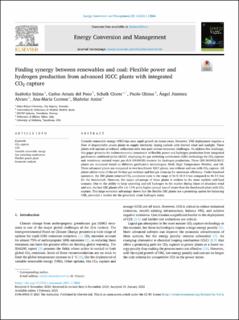| dc.contributor.author | Szima, Szabolcs | |
| dc.contributor.author | Arnáiz del Pozo, Carlos | |
| dc.contributor.author | Cloete, Schalk Willem Petrus | |
| dc.contributor.author | Chiesa, Paolo | |
| dc.contributor.author | Álvaro, Ángel Jiménez | |
| dc.contributor.author | Cormos, Ana-Maria | |
| dc.contributor.author | Amini, Shahriar | |
| dc.date.accessioned | 2021-10-05T13:52:47Z | |
| dc.date.available | 2021-10-05T13:52:47Z | |
| dc.date.created | 2021-02-11T10:05:39Z | |
| dc.date.issued | 2021 | |
| dc.identifier.citation | Energy Conversion and Management. 2021, 231 1-12. | en_US |
| dc.identifier.issn | 0196-8904 | |
| dc.identifier.uri | https://hdl.handle.net/11250/2787811 | |
| dc.description.abstract | Variable renewable energy (VRE) has seen rapid growth in recent years. However, VRE deployment requires a fleet of dispatchable power plants to supply electricity during periods with limited wind and sunlight. These plants will operate at reduced utilization rates that pose serious economic challenges. To address this challenge, this paper presents the techno-economic assessment of flexible power and hydrogen production from integrated gasification combined cycles (IGCC) employing the gas switching combustion (GSC) technology for CO2 capture and membrane assisted water gas shift (MAWGS) reactors for hydrogen production. Three GSC-MAWGS-IGCC plants are evaluated based on different gasification technologies: Shell, High Temperature Winkler, and GE. These advanced plants are compared to two benchmark IGCC plants, one without and one with CO2 capture. All plants utilize state-of-the-art H-class gas turbines and hot gas clean-up for maximum efficiency. Under baseload operation, the GSC plants returned CO2 avoidance costs in the range of 24.9–36.9 €/ton compared to 44.3 €/ton for the benchmark. However, the major advantage of these plants is evident in the more realistic mid-load scenario. Due to the ability to keep operating and sell hydrogen to the market during times of abundant wind and sun, the best GSC plants offer a 6–11%-point higher annual rate of return than the benchmark plant with CO2 capture. This large economic advantage shows that the flexible GSC plants are a promising option for balancing VRE, provided a market for the generated clean hydrogen exists. | en_US |
| dc.language.iso | eng | en_US |
| dc.publisher | Elsevier | en_US |
| dc.rights | Navngivelse 4.0 Internasjonal | * |
| dc.rights.uri | http://creativecommons.org/licenses/by/4.0/deed.no | * |
| dc.subject | Economic analysis | en_US |
| dc.subject | Flexible power plant | en_US |
| dc.subject | Gas switching combustion | en_US |
| dc.subject | Variable renewable energy | en_US |
| dc.subject | CCS | en_US |
| dc.subject | CO2 capture | en_US |
| dc.title | Finding synergy between renewables and coal: Flexible power and hydrogen production from advanced IGCC plants with integrated CO2 capture | en_US |
| dc.type | Peer reviewed | en_US |
| dc.type | Journal article | en_US |
| dc.description.version | publishedVersion | en_US |
| dc.rights.holder | 2021 The Author(s). Published by Elsevier Ltd. | en_US |
| dc.source.pagenumber | 1-12 | en_US |
| dc.source.volume | 231 | en_US |
| dc.source.journal | Energy Conversion and Management | en_US |
| dc.identifier.doi | 10.1016/j.enconman.2021.113866 | |
| dc.identifier.cristin | 1888749 | |
| cristin.ispublished | true | |
| cristin.fulltext | original | |
| cristin.qualitycode | 1 | |

